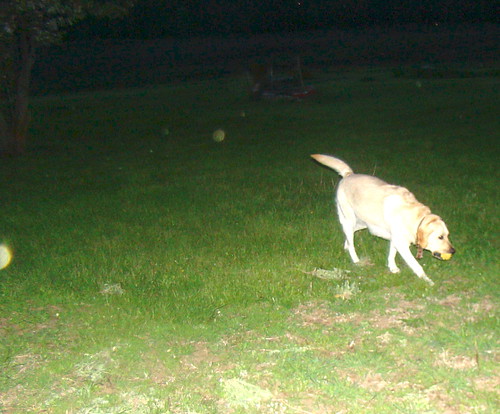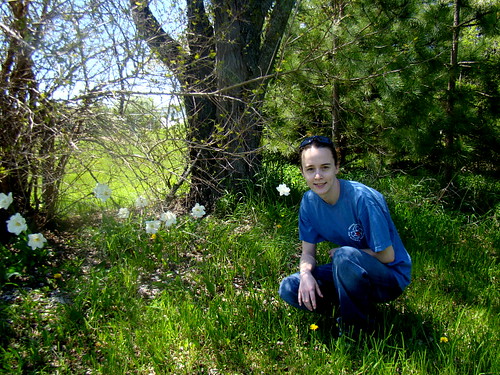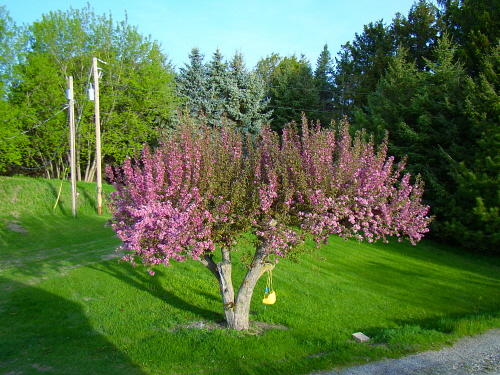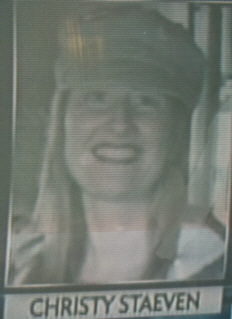
- Sputty, protesting the windows being open all night..
I did not tuck the poor thing in either,
I don't have to, he does this all by himself.
.
Good Evening;
Like a wee baby, I seem to have my days and nights all mixed up.
I awoke at 10~ish last night, and stayed up. I did nap for 2 hours this afternoon, so perhaps I can get this day/night thing back to 'normal'. hehehe (I hate using that word because I never know what 'n0rmal' is supposed to be to begin with).
.
.
.
I left all my windows open last night in the hopes that maybe I could keep it cooler inside today. I closed them about 6 this morning as the temperatures began to rise. I believe our high here was 84 or 85. Talk about a shock! Tomorrow is to be decent though- and again they have promised a bit of rain.
Hard to believe we need it, especially when the disk is 4" deep in mud in some parts of the field. This postpones planting these 20 acres 'til when?
.
.
.
.
.
.
Casey came out today, and after a bit of walking around in search of new blooms, she went straight to work.
First the blooms...
.
.
..
.
.
Then the work she did...
.
.
.
.
.
.
Say what you will, I say it's a darn fine thing that she has had her little surgeries and is once again capable of doing her fair share.
All kidding aside, this was an irresistible photo op.
.
The crab apple tree is in bloom also. And after the trimming it had a year and a half ago, methinks it looks like some pink and purple two~headed troll..
.
.
.
My own old crab tree seemingly pales in comparison to what Miss Micki has written on Baby Mariahs Caring Bridge Site CLICK FOR HER SITE
"The crab apple trees next to Mariah’s grave in the cemetery have bloomed and they are just gorgeous! I tried to take a picture but pictures really don’t capture the beauty of it at all. The flowers are pink and there’s just enough shade to have a picnic underneath. We purchased the tree next to Mariah’s grave so that we can hang anything on it we wish to. There will eventually be a plaque underneath it that will represent the Klein Family."
*Micki, if you stop by to read this, please know that I read your blogs. I have updated my info on Caring Bridge a while back and it worked for a time... Now I keep trying to comment and it won't work. As always, I do send my heart & love to your whole family.
.
.
I also took this picture from my bedroom window- Peeking through the yews are the tulips that I had waited ever so long for. They are now almost wilted and done for yet another year.
.
.
.
.
.
Wednesday today, and I brought the garbage dumpster out just before sunrise. - (I also collected my mail that had been waiting for me since Saturday).
sigh... Somebody MUST have stolen that Publisher ClearingHouse Check.
.
.
.
Do you see the quarter moon peeking through the blossoms?.
Centered. Almost. About an inch or so down.
.
I went out to the pumphouse and dragged Punks little pool out. I tried to fill it, but the water leaked out. - (And I shall fix that looming rain gutter as soon as my back permits).When we had been in the house there was a new cat out on the front lawn. She damn near had jumped through the window to get to it.
.
And yes, Punk found herself tied up for a while...
- She remained tied until Casey and I determined that the cat was gone.
.
.
For those of you keeping up, or wanting to, this was on the news. Kelli called to tell me to turn the news on tonight
http://www.wbay.com/Global/story.asp?S=10398403
.
.
.
.
Woman Found Dead in Oconto County Fire Was Murdered
Updated: May 20, 2009 04:49 PM
Authorities in Oconto County say a woman found dead in a house fire near Pulaski last week was murdered before the fire was set.
Trust me when I say this, no one wanted to be wrong about my intuitions more than myself. By now you all know that I have a tendency to call a spade a spade... - I also shoot from the hip- (both literally and figuratively).
I know that I have offended at least one of you by stating how I felt about this all before the coroner had released this today. My apologies for that.
As of the 6 o'clock news no one is in custody. Oconto County is notoriously slow or absent with their arrest records, (or at least that was my own experience when my daughter was raped and almost bled to death). Idiots.
- Time will tell how they handle her murder, and the arson that followed.
When we have children, we want and choose to raise them in a way that we feel to be safe, secure, and away from the dark-spirited people of the world. Moving from the townhouses in Ashwaubenon to being way out in the country in Pulaski seemed a wonderful relocation for us all, and most especially for my girls.
Things are not always what they seem.
My love to all.
XOXO
Anne
Things Are Not Always What They Seem
New Program to Develop Therapeutics for Rare and Neglected Diseases
http://www.nih.gov/news/health/may2009/nhgri-20.htm
A rare disease is one that affects fewer than 200,000 Americans. NIH estimates that, in total, more than 6,800 rare diseases afflict more than 25 million Americans. However, effective pharmacologic treatments exist for only about 200 of these illnesses. Many neglected diseases also lack treatments. Unlike rare diseases, however, neglected diseases may be quite common in some parts of the world, especially in developing countries where people cannot afford expensive treatments. Private companies seldom pursue new therapies for these types of illnesses because of high costs and failure rates and the low likelihood of recovering investments or making a profit.
The National Institutes of Health is launching the first integrated, drug development pipeline to produce new treatments for rare and neglected diseases. The $24 million program jumpstarts a trans-NIH initiative called the Therapeutics for Rare and Neglected Diseases program, or TRND.
The program is unusual because TRND creates a drug development pipeline within the NIH and is specifically intended to stimulate research collaborations with academic scientists working on rare illnesses. The NIH Office of Rare Diseases Research (ORDR) will oversee the program, and TRND’s laboratory operations will be administered by the National Human Genome Research Institute (NHGRI), which also operates the NIH Chemical Genomics Center (NCGC), a principal collaborator in TRND. Other NIH components will also participate in the initiative.
"NIH is eager to begin the work to find solutions for millions of our fellow citizens faced with rare or neglected illnesses," said NIH Acting Director Raynard S. Kington, M.D., Ph.D. "The federal government may be the only institution that can take the financial risks needed to jumpstart the development of treatments for these diseases, and NIH clearly has the scientific capability to do the work."
Developing Drugs
The drug development process is complicated and expensive. Studies suggest that it currently takes more than a dozen years and hundreds of millions of dollars to take a potential drug from discovery to the marketplace. And the failure rate is high.
"This initiative is really good news for patients with rare or neglected diseases," said ORDR Director Stephen C. Groft, Pharm.D. "While Congress has previously taken important steps to help these patients, such as providing incentives for drug companies under the Orphan Drug Act, this is the first time NIH is providing support for specific, preclinical research and product development known to be major barriers preventing potential therapies from entering into clinical trials for rare or neglected disorders. While we do not underestimate the difficulty of developing treatments for people with these illnesses, this program provides new hope to many people world-wide."
Typically, drug development begins when academic researchers studying the underlying cause of a disease discover a new molecular target or a chemical that may have a therapeutic effect. Too often, the process gets stuck at the point of discovery because few academic researchers can conduct all the types of studies needed to develop a new drug. If a pharmaceutical company with the resources to further the research does get involved, substantial preclinical work begins with efforts to optimize the chemistry of the potential drug. This involves an iterative series of chemical modifications and tests in progressively more complex systems — from cell cultures to animal tests — to refine the potential medicine for use in people. Only if these stages are successful can a potential treatment move to clinical trials in patients.
Unfortunately, the success rate in this preclinical process is low, with 80 to 90 percent of projects failing in the preclinical phase and never making it to clinical trials. And the costs are high: it takes two to four years of work and $10 million, on average, to move a potential medicine though this preclinical process. Drug developers colloquially call this the "Valley of Death."
TRND will work closely with disease-specific experts on selected projects, leveraging both the in-house scientific capabilities needed to carry out much of the preclinical development work, and contracting out other parts, as scientific opportunities dictate. Its strategies will be similar to approaches taken by pharmaceutical and biotechnology companies, but TRND will be working on diseases mostly ignored by the private companies. Importantly, TRND will also devote some of its efforts to improving the drug development process itself, creating new approaches to make it faster and less expensive.
If a compound does survive this preclinical stage, TRND will work to find a company willing to test the therapy in patients. There are several stages to the clinical trials process that can take several years before the safety and efficacy of a new drug is determined. FDA will only approve a drug for general use after it passes these trials. The clinical trials process is also expensive, but the failure rate is lower at this stage.
"NIH traditionally invests in basic research, which has produced important discoveries across a wide range of illnesses," said NHGRI Acting Director Alan E. Guttmacher, M.D. "Biotechnology and pharmaceutical companies have enormous strength and experience in drug development, but to maximize return-on-investment work primarily on common illnesses. TRND will develop promising treatments for rare diseases to the point that they are sufficiently "de-risked" for pharmaceutical companies, disease-oriented foundations, or others, to undertake the necessary clinical trials. NIH’s goal is to get new medications to people currently without treatment, and thus without hope."
NIH already has many components of the drug development pipeline within its research programs. TRND will begin its work in collaboration with the NIH Chemical Genomics Center (NCGC), a center initially developed as part of the NIH Roadmap for Medical Research. NCGC has developed a robotic, high-throughput screening system and a library of more than 350,000 compounds that it uses to make basic discoveries and probe cellular pathways. NCGC also has developed a team of researchers skilled in developing assays representing disease processes that can be tested in its screening system, and has extensive experience building collaborative projects with investigators from across the research community. Molecules with potential therapeutic properties that emerge from the NCGC screening process could be fed into the TRND drug development pipeline.
"With this new funding, TRND will develop teams of scientists who can do the hard work of optimizing chemicals that we or others discover that may treat rare diseases and turn them into actual drugs," said NCGC Director Christopher P. Austin, M.D., who is also the Senior Advisor for Translational Research to the NHGRI Director. "This will still be hard work and it will take time and produce failures. Unlike traditional drug development, however, where only successes are published, we will publish our failures as well, so everyone in the drug development community can learn from them. That alone could be revolutionary."
If all the preclinical hurdles can be crossed, a possible treatment must still be tested in a series of clinical trials. TRND will seek to take advantage of several NIH resources that can help launch human studies, including the NIH Clinical Center, the NIH Rapid Access to Interventional Development (NIH-RAID), and the Clinical and Translational Science Awards (CTSA) program.
External Partners
Numerous obstacles impede the development of new drugs for rare and neglected diseases. In addition to the reluctance of private companies to risk their capital on a potentially low return, relatively few basic researchers study rare diseases, so the underlying cause of the illness frequently remains unknown. And, because rare diseases are rare, researchers often have difficulty recruiting enough people with the disorder to participate in a clinical trial once a candidate compound reaches the stage where it can be tested in people. Moreover, for many rare diseases, the natural history of the disease is poorly understood, so researchers lack the needed clinical measures (such as blood pressure) that can demonstrate whether a treatment is working.
To address these difficulties, TRND will seek a wide range of collaborations with academic researchers, as well as partnerships with patient advocacy organizations, disease-oriented foundations and others interested in treatments for particular illnesses. TRND’s leaders hope that the collaborations will help lay the groundwork for clinical trials once that point in drug development is reached.
TRND is currently setting up an oversight process to help it decide which projects that address thousands of rare and neglected diseases will be pursued. Leadership currently envisions a small number of diseases being studied each year, with strict criteria used to determine which molecules will be studied for which diseases. NIH expects to use existing intellectual property policies to transfer licenses for TRND-discovered drugs to private companies or others for development, clinical testing and marketing.
Frequently asked questions about this new program are available online at:
* FAQ on the Therapeutics for Rare or Neglected Diseases (TRND) program: www.genome.gov/27531965
* TRND FAQ on Neglected Diseases: www.genome.gov/27531964
* TRND FAQ on Rare Diseases: www.genome.gov/27531963
Follow this link for full-resolution b-roll clips from the NCGC facility which will be involved in TRND, www.genome.gov/pressDisplay.cfm?photoID=20030
The Office of Rare Diseases Research is one of the programmatic offices in the Office of the Director of the NIH.
For more about ORDR, visit http://rarediseases.info.nih.gov/.
The Office of the Director, the central office at NIH, is responsible for setting policy for NIH, which includes 27 Institutes and Centers. This involves planning, managing, and coordinating the programs and activities of all NIH components. The Office of the Director also includes program offices which are responsible for stimulating specific areas of research throughout NIH. Additional information is available at http://www.nih.gov/icd/od/.
The National Human Genome Research Institute is one of the 27 institutes and centers at the NIH, an agency of the Department of Health and Human Services. The NHGRI Division of Intramural Research develops and implements technology to understand, diagnose and treat genomic and genetic diseases. Additional information about NHGRI can be found at its Web site, www.genome.gov.
The National Institutes of Health (NIH) — The Nation's Medical Research Agency — includes 27 Institutes and Centers and is a component of the U.S. Department of Health and Human Services. It is the primary federal agency for conducting and supporting basic, clinical and translational medical research, and it investigates the causes, treatments, and cures for both common and rare diseases. For more information about NIH and its programs, visit www.nih.gov.
A rare disease is one that affects fewer than 200,000 Americans. NIH estimates that, in total, more than 6,800 rare diseases afflict more than 25 million Americans. However, effective pharmacologic treatments exist for only about 200 of these illnesses. Many neglected diseases also lack treatments. Unlike rare diseases, however, neglected diseases may be quite common in some parts of the world, especially in developing countries where people cannot afford expensive treatments. Private companies seldom pursue new therapies for these types of illnesses because of high costs and failure rates and the low likelihood of recovering investments or making a profit.
The National Institutes of Health is launching the first integrated, drug development pipeline to produce new treatments for rare and neglected diseases. The $24 million program jumpstarts a trans-NIH initiative called the Therapeutics for Rare and Neglected Diseases program, or TRND.
The program is unusual because TRND creates a drug development pipeline within the NIH and is specifically intended to stimulate research collaborations with academic scientists working on rare illnesses. The NIH Office of Rare Diseases Research (ORDR) will oversee the program, and TRND’s laboratory operations will be administered by the National Human Genome Research Institute (NHGRI), which also operates the NIH Chemical Genomics Center (NCGC), a principal collaborator in TRND. Other NIH components will also participate in the initiative.
"NIH is eager to begin the work to find solutions for millions of our fellow citizens faced with rare or neglected illnesses," said NIH Acting Director Raynard S. Kington, M.D., Ph.D. "The federal government may be the only institution that can take the financial risks needed to jumpstart the development of treatments for these diseases, and NIH clearly has the scientific capability to do the work."
Developing Drugs
The drug development process is complicated and expensive. Studies suggest that it currently takes more than a dozen years and hundreds of millions of dollars to take a potential drug from discovery to the marketplace. And the failure rate is high.
"This initiative is really good news for patients with rare or neglected diseases," said ORDR Director Stephen C. Groft, Pharm.D. "While Congress has previously taken important steps to help these patients, such as providing incentives for drug companies under the Orphan Drug Act, this is the first time NIH is providing support for specific, preclinical research and product development known to be major barriers preventing potential therapies from entering into clinical trials for rare or neglected disorders. While we do not underestimate the difficulty of developing treatments for people with these illnesses, this program provides new hope to many people world-wide."
Typically, drug development begins when academic researchers studying the underlying cause of a disease discover a new molecular target or a chemical that may have a therapeutic effect. Too often, the process gets stuck at the point of discovery because few academic researchers can conduct all the types of studies needed to develop a new drug. If a pharmaceutical company with the resources to further the research does get involved, substantial preclinical work begins with efforts to optimize the chemistry of the potential drug. This involves an iterative series of chemical modifications and tests in progressively more complex systems — from cell cultures to animal tests — to refine the potential medicine for use in people. Only if these stages are successful can a potential treatment move to clinical trials in patients.
Unfortunately, the success rate in this preclinical process is low, with 80 to 90 percent of projects failing in the preclinical phase and never making it to clinical trials. And the costs are high: it takes two to four years of work and $10 million, on average, to move a potential medicine though this preclinical process. Drug developers colloquially call this the "Valley of Death."
TRND will work closely with disease-specific experts on selected projects, leveraging both the in-house scientific capabilities needed to carry out much of the preclinical development work, and contracting out other parts, as scientific opportunities dictate. Its strategies will be similar to approaches taken by pharmaceutical and biotechnology companies, but TRND will be working on diseases mostly ignored by the private companies. Importantly, TRND will also devote some of its efforts to improving the drug development process itself, creating new approaches to make it faster and less expensive.
If a compound does survive this preclinical stage, TRND will work to find a company willing to test the therapy in patients. There are several stages to the clinical trials process that can take several years before the safety and efficacy of a new drug is determined. FDA will only approve a drug for general use after it passes these trials. The clinical trials process is also expensive, but the failure rate is lower at this stage.
"NIH traditionally invests in basic research, which has produced important discoveries across a wide range of illnesses," said NHGRI Acting Director Alan E. Guttmacher, M.D. "Biotechnology and pharmaceutical companies have enormous strength and experience in drug development, but to maximize return-on-investment work primarily on common illnesses. TRND will develop promising treatments for rare diseases to the point that they are sufficiently "de-risked" for pharmaceutical companies, disease-oriented foundations, or others, to undertake the necessary clinical trials. NIH’s goal is to get new medications to people currently without treatment, and thus without hope."
NIH already has many components of the drug development pipeline within its research programs. TRND will begin its work in collaboration with the NIH Chemical Genomics Center (NCGC), a center initially developed as part of the NIH Roadmap for Medical Research. NCGC has developed a robotic, high-throughput screening system and a library of more than 350,000 compounds that it uses to make basic discoveries and probe cellular pathways. NCGC also has developed a team of researchers skilled in developing assays representing disease processes that can be tested in its screening system, and has extensive experience building collaborative projects with investigators from across the research community. Molecules with potential therapeutic properties that emerge from the NCGC screening process could be fed into the TRND drug development pipeline.
"With this new funding, TRND will develop teams of scientists who can do the hard work of optimizing chemicals that we or others discover that may treat rare diseases and turn them into actual drugs," said NCGC Director Christopher P. Austin, M.D., who is also the Senior Advisor for Translational Research to the NHGRI Director. "This will still be hard work and it will take time and produce failures. Unlike traditional drug development, however, where only successes are published, we will publish our failures as well, so everyone in the drug development community can learn from them. That alone could be revolutionary."
If all the preclinical hurdles can be crossed, a possible treatment must still be tested in a series of clinical trials. TRND will seek to take advantage of several NIH resources that can help launch human studies, including the NIH Clinical Center, the NIH Rapid Access to Interventional Development (NIH-RAID), and the Clinical and Translational Science Awards (CTSA) program.
External Partners
Numerous obstacles impede the development of new drugs for rare and neglected diseases. In addition to the reluctance of private companies to risk their capital on a potentially low return, relatively few basic researchers study rare diseases, so the underlying cause of the illness frequently remains unknown. And, because rare diseases are rare, researchers often have difficulty recruiting enough people with the disorder to participate in a clinical trial once a candidate compound reaches the stage where it can be tested in people. Moreover, for many rare diseases, the natural history of the disease is poorly understood, so researchers lack the needed clinical measures (such as blood pressure) that can demonstrate whether a treatment is working.
To address these difficulties, TRND will seek a wide range of collaborations with academic researchers, as well as partnerships with patient advocacy organizations, disease-oriented foundations and others interested in treatments for particular illnesses. TRND’s leaders hope that the collaborations will help lay the groundwork for clinical trials once that point in drug development is reached.
TRND is currently setting up an oversight process to help it decide which projects that address thousands of rare and neglected diseases will be pursued. Leadership currently envisions a small number of diseases being studied each year, with strict criteria used to determine which molecules will be studied for which diseases. NIH expects to use existing intellectual property policies to transfer licenses for TRND-discovered drugs to private companies or others for development, clinical testing and marketing.
Frequently asked questions about this new program are available online at:
* FAQ on the Therapeutics for Rare or Neglected Diseases (TRND) program: www.genome.gov/27531965
* TRND FAQ on Neglected Diseases: www.genome.gov/27531964
* TRND FAQ on Rare Diseases: www.genome.gov/27531963
Follow this link for full-resolution b-roll clips from the NCGC facility which will be involved in TRND, www.genome.gov/pressDisplay.cfm?photoID=20030
The Office of Rare Diseases Research is one of the programmatic offices in the Office of the Director of the NIH.
For more about ORDR, visit http://rarediseases.info.nih.gov/.
The Office of the Director, the central office at NIH, is responsible for setting policy for NIH, which includes 27 Institutes and Centers. This involves planning, managing, and coordinating the programs and activities of all NIH components. The Office of the Director also includes program offices which are responsible for stimulating specific areas of research throughout NIH. Additional information is available at http://www.nih.gov/icd/od/.
The National Human Genome Research Institute is one of the 27 institutes and centers at the NIH, an agency of the Department of Health and Human Services. The NHGRI Division of Intramural Research develops and implements technology to understand, diagnose and treat genomic and genetic diseases. Additional information about NHGRI can be found at its Web site, www.genome.gov.
The National Institutes of Health (NIH) — The Nation's Medical Research Agency — includes 27 Institutes and Centers and is a component of the U.S. Department of Health and Human Services. It is the primary federal agency for conducting and supporting basic, clinical and translational medical research, and it investigates the causes, treatments, and cures for both common and rare diseases. For more information about NIH and its programs, visit www.nih.gov.
Tags/Labels:
nih
Subscribe to:
Comments (Atom)








